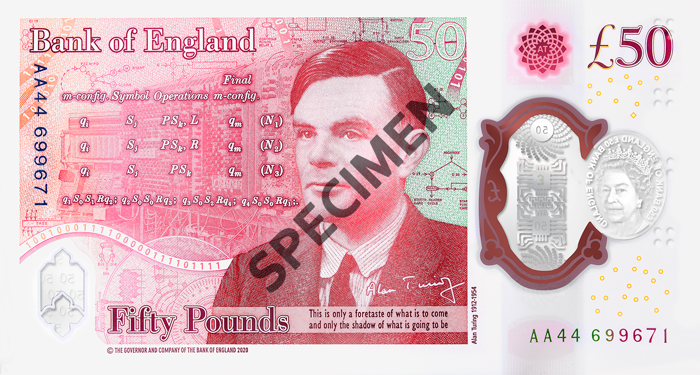The Bank of England’s new £50 note, launched on 25th March, marks the transition of the full series of English notes to GUARDIAN™ polymer substrate. For CCL Secure, the makers of GUARDIAN, the launch marks the 11th time that a country has transitioned all its banknotes to polymer.
The launch of the new £50 note has been trailed on the Bank of England’s website and in social media for several months now, with emphasis on both the security features that are built into the note and the design, which features computing pioneer Alan Turing.

Turing provided the theoretical underpinnings for the modern computer via his work at the National Physical Laboratory and later at the University of Manchester. He’s also regarded as instrumental in the development of the theory of artificial intelligence, setting the ‘Turing Test’ to assess how successfully a machine can exhibit behaviours that are indistinguishable from a human.
As well as including an image of Turing, the note includes design elements that draw on his writings and other aspects of his work. Security features, many of which are achievable only with polymer substrate, include two windows and a two-colour foil, making it very difficult to counterfeit. There is also a hologram image which changes between the words ‘Fifty’ and ‘Pounds’ when tilting the note from side to side.
“We’ve been working with the Bank of England on polymer transition from the very beginning, the launch of the £5 note in 2016,” says CCL Secure MD Neil Sanders. “Now that the full series is transitioned, we’re immensely proud to have supplied the vast majority of the substrate that the Bank has used to produce its polymer notes.”
As part of their original contract with the Bank of England for the £5 and subsequent £10 and £20 notes, CCL Secure invested £40m in new production facilities at Wigton, Cumbria, creating 80 skilled jobs. The highly secure production facility makes a unique form of polymer banknote substrate – GUARDIAN - based on Propanote™ Clarity C film, which is also produced onsite by sister company Innovia Films. Propanote™ Clarity C is used solely for banknotes and no other purpose. Both companies are part of the CCL Industries Group.
The Bank of England’s new £50 note is the latest in a large number of GUARDIAN polymer banknotes that CCL Secure has helped central banks around the world to release in the past 18 months. Since the beginning of 2020 – and despite the challenges of the global pandemic – new GUARDIAN polymer notes have been issued in Angola, Costa Rica, Lebanon, Mexico, Namibia, Nicaragua, and Saudi Arabia.
The key features of the new £50 include:
- A photo of Turing taken in 1951 by Elliott & Fry which is part of the Photographs Collection at the National Portrait Gallery. A table and mathematical formulae from Turing’s seminal 1936 paper “On Computable Numbers, with an application to the Entscheidungsproblem” Proceedings of the London Mathematical Society. This paper is widely recognised as being foundational for computer science. It sought to establish whether there could be a definitive method by which any theorem could be assessed as provable or not using a universal machine. It introduced the concept of a Turing machine as a thought experiment of how computers could operate.
- The Automatic Computing Engine (ACE) Pilot Machine which was developed at the National Physical Laboratory as the trial model of Turing’s pioneering ACE design. The ACE was one of the first electronic stored-program digital computers.
- Technical drawings for the British Bombe, the machine specified by Turing and one of the primary tools used to break Enigma-enciphered messages during WWII.
- A quote from Alan Turing, given in an interview to The Times newspaper on 11 June 1949: “This is only a foretaste of what is to come, and only the shadow of what is going to be.”
- Turing’s signature from the visitor’s book at Max Newman’s House in 1947 which is on display at Bletchley Park, where he worked during WWII.
- Ticker tape depicting Alan Turing’s birth date (23 June 1912) in binary code. The concept of a machine fed by binary tape featured in the Turing’s 1936 paper.
Two key security features can be checked to help confirm that note are genuine:
- a metallic hologram which changes between the words ‘Fifty’ and ‘Pounds’ when the note is tilted.
- a large see-through window with a gold and green foil on the front depicting a finely detailed metallic microchip image.
- There are two green 21 spiral features based on a sunflower head (linked to Turing’s morphogenetic work in later life). The foil is silver on the back.
- A metallic hologram which changes between the words ‘Fifty’ and ‘Pounds’ when the note is tilted.
- A silver foil patch with a 3D image of the coronation crown.
- The Queen’s portrait in the see-through window with ‘£50 Bank of England’ printed twice around the edge. (The small clover shapes on the outside of the window are based on architectural features at Bletchley Park.)
- A smaller see-through window in the bottom corner of the note, the shape of which is based on architectural features at Bletchley Park.
- A red foil patch containing the letters ‘AT’ is based on the image of a sunflower head linked to Turing’s morphogenetic work in later life.